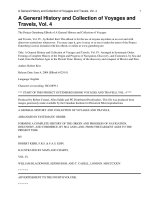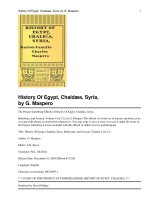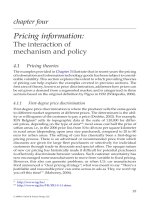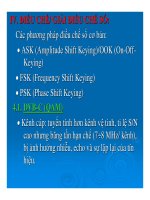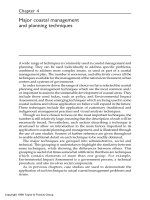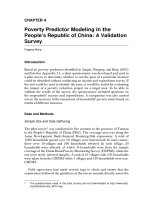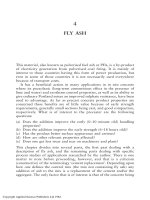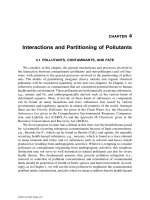Luminescent metal complexes containing naphthalene and anthracene units 4
Bạn đang xem bản rút gọn của tài liệu. Xem và tải ngay bản đầy đủ của tài liệu tại đây (3.49 MB, 103 trang )
97
Chapter 4
Synthesis, Structures and photooxidation of
Pt(II)- and Pd(II)-1.8-bis(diphenylphophosphino)anthracene-
Complexes
98
4.1 Introduction
As mentioned in the previous chapter, the photochemistry, especially the photooxidation
of d
8
Pt
II
complexes is very rich. Described in this chapter is the synthesis of a reported
diphosphine 1,8-bis(diphenylphosphino)anthracene (DAP) and its Pt(II) and Pd(II) complexes.
The structures, electronic spectroscopy, luminescence photochemical reactivity of the complexes
were examined. Particularly, the photooxidations of the complex Pt(DAP)Cl were studied in
details. The results showed a neat photoinduced four-electron reduction of oxygen.
Organoplatinum(II) Pt(PCP)Cl (PCP = 1, 3-bis(diphenylphosphino)benzene) is shown in Scheme
4.1, which contains a pincer type ligand.
PtPh
2
P PPh
2
Cl
Scheme 4.1
Pt(PCP)Cl
4.2 Result and Discussion
4.2.1 Synthesis of 1, 8-bis(diphenylphosphino)anthracene
1,8-bis(diphenylphosphino)anthracene (DAP) cannot be synthesized through the usual
way from 1,8-dichloroanthracene. It is impossible to convert 1,8-dichloroanthracene by twofold
metallation into the dilithium compound by n-Buli or the di-Grignard compound, and then
substitute the metal by diphenylphosphine. It can be obtained in moderate yield of 33% by
reaction of potassium anthracene disulfonate with two equivalents potassium diphenylphosphide
(Ph
2
PK) in diethylene glycol diethyl under harsh reaction conditions (180°C, 20h).
1
A relatively
simple method was developed by Haenel.
2
1,8-difluroanthracene was prepared from the
commercially available 1,8-dichloro-9,10-anthraquinone in a two-step synthesis. 1,8-
99
difluroanthracene as starting materials is proved to be highly reactive for nucleophilic
displacement of the fluoro substituents by alkali metal phosphides. Reaction with two equivalents
potassium diphenylphosphine, 1,8-difluroanthracene was converted to 1,8-
bis(diphenylphosphino)anthracene with high yield (51%, three steps). It is a yellow powder with
strong smell, which can dissolve well in aprotic solutions such as CH
2
Cl
2
or CHCl
3
. The
1
H
NMR and
31
P NMR (CDCl
3
, 121.4M Hz) are consistent with the reported result.
1,2
In the
1
H-
NMR spectrum (CDCl
3
, 300M Hz) of PCP ligand the signals of the anthracene 9,10-H are widely
separated (δ = 9.80 ppm and 8.45 ppm). Other protons of anthracene locate at 7.97 ppm, 7.78
ppm and 7.29 ppm. The phenyl protons are in the range of 7.32-7.40 ppm. In
31
P{
1
H}-NMR
spectrum (CDCl
3
, 121.5M Hz) shows a singlet at -14.6 ppm. Another way to synthesized the
DAP ligand is to get 1-fluro-8-phenylphosphinoantracene by reaction of 1,8-difluroanthracene
and sodium diphenylphosphine at first, then convert 1-fluro-8-phenylphosphinoantracene to DAP
using excess sodium diphenylphosphine in dioxane. Yield is 35%.
4.2.2 Synthesis and Structure of Pt(DAP)Cl (4.1)
The complex can be prepared by refluxing either a chloroform solution of DAP with 1
mol equiv of PtCl
2
(CH
3
CN)
2
or a CH
3
CN/H
2
O mixture of DAP and K
2
PtCl
4
for 1 day. Addition
of excess diethyl ether to the solution precipitated the product Pt(DAP)Cl as pale yellow powders.
The complex can dissolve well in aprotic solutions such as CH
2
Cl
2
, CHCl
3
and DMF but it is
only sparingly soluble in CH
3
OH and CH
3
CN. Orange crystals were obtained by slow
evaporation of acetonitrile solution of the complex. The structure was confirmed by single crystal
X-ray diffraction.
100
Figure 4.1 ORTEP plot of 4.1·CH
3
CN. Thermal ellipsoids are drawn with 50% probability. The
hydrogen atoms and solvent are omitted for clairity.
The X-ray crystal structure of Pt(DAP)Cl and the selected bond lengths and angles are
shown in Figure 4.1 and Table 4.1, respectively. The complex displays an approximate C
2v
symmetry in which the platinum atom adopts a distorted square-planar coordination geometry
which is typical for Pt(II) compounds. The metal atom is coordinated to the two P atoms of DAP
and the deprotonated C(9) of anthracenyl ring. A chloride ion coordinates trans to the carbon
atom. The C(9)-Pt-Cl(1) linkage is nearly linear (177.54(10)°). However, The P(1)-Pt-P(2) angle
of deviates significantly from linearity. The angle of P(2)-Pt(1)-C(9) of 83.70°, P(1)-Pt(1)-C(9)
of 83.79°, P(2)-Pt(1)-Cl(1) of 94.53° and P(2)-Pt(1)-Cl(1) of 97.92° deviate from 90°. Compared
with the angle of N-Pt-N (78.1(4)°) and N-Pt-P (105.4(3)°) in other Pt(II) complexes like
[Pt(CNN)PPh
3
]
+
(CNN=6-phenyl-2,2’-bypridine),
3
The square plane is not distorted greatly. The
data are very close to the structure of Pt(PCP)Cl (PCP = 1, 3-bis(diphenylphosphino)benzene),
4b
(C-Pt-P = 82.3(3)° and P-Pt-Cl = 99.44(9)°). The torsion angle of P(2)-C(3)-C(9)-Pt(1) is 1.15°
and P(1)-C(1)-C(9)-Pt(1) is 0.05° show three bonds, Pt(1)-C(9), C(8)-P(2) and C(1)-P(1) are
almost parallel.
The Pt-C(9) distance of 1.991(3) Å is similar to the bond distances observed in other
cyclometallated Pt(II) complexes such as Pt(PCP)(CF
2
CF
2
CF
3
) (PCP = 1, 3-
101
bis(diphenylphosphino)benzene).
4a
The distance from Pt to the arene is 2.072(7) Å. In Pt(PCP)X
( X=Cl, Br, CO
2
H), the Pt-C is in the range of 2.003(9)-2.066(3) Å.
4b
The bond average Pt-P
distance is 2.2685 Å. Compared with other Pt complexes, Pt-P is in the range of 2.275-2.381 Å,
such as 2.2753(12)-2.3159(10) Å in Pt(PCP)
+
( PCP= [C
6
H
3
(CH
2
PPh
2
)
2
-2,6]
-
),
5
these bond
lengths are in the normal range.
6
Pt(1)-Cl(1)= 2.3914(9) is also in the same range. The average
Pt-Cl distance is 2.324(2) Å, 2.309(3) Å and 2.317(1) Å in cis-[PtCl
2
(1,4-thioxane)
2
], cis-
[PtCl
2
(DMSO)
2
] and cis-[PtCl
2
(dms)
2
] sequently.
7
Pt-Cl bond is 2.384(2) Å in the
PtPh(PPh
2
)
2
Cl.
4b
Side view of 4.1·CH
3
CN in Figure 4.2 shows the main framework is highly planar. The
mean deviation of C atom on anthracenyl ring plane is only 0.0272 Å. It has extremely small
dihedral angle of 1.75° between the lateral rings of anthracene. The two P atoms are also
coplanar with the anthracenyl rings as they are on the same side of anthracenyl plane. The
distance from the anthracenyl ring is 0.0334 Å and 0.0636 Å respectively. The deviation of the Pt
atom from anthracene plane is -0.0203 Å which is on the opposite side of two P atoms and Cl
atom. The Cl atom has a 0.0757 Å deviation to the anthracene.
Figure 4.2 ORTEP diagrams showing the side view of 4.1·CH
3
CN
Thermal ellipsoid are drawn with 50% probability. All the hydrogen atoms and solvent are
omitted for clarity.
102
Table 4.1 Selected bond length(Å) and angles(deg) of 4.1
Bond Lengths Bond angles
Pt(1)-C(9)
Pt(1)-P(2)
Pt(1)-P(1)
Pt(1)-Cl(1)
P(1)-C(1)
P(2)-C(8)
C(9)-C(11)
C(9)-C(13)
C(13)-C(8)
C(13)-C(14)
C(12)-C(7)
C(1)-C(11)
1.991(3)
2.2664(9)
2.2705(9)
2.3914(9)
1.809(4)
1.803(4)
1.411(5)
1.413(5)
1.432(5)
1.435(5)
1.435(5)
1.441(5)
C(9)-Pt(1)-P(2)
C(9)-Pt(1)-P(1)
P(2)-Pt(1)-P(1)
C(9)-Pt(1)-Cl(1)
P(2)-Pt(1)-Cl(1)
P(1)-Pt(1)-Cl(1)
C(11)-C(9)-C(13)
C(11)-C(9)-Pt(1)
C(13)-C(9)-Pt(1)
C(7)-C(8)-P(2)
C(13)-C(8)-P(2)
C(2)-C(1)-P(1)
83.79(10)
83.70(10)
167.34(3)
177.54(10)
94.53(3)
97.92(3)
117.3(3)
121.5(2)
121.2(2)
127.0(3)
112.0(2)
127.6(3)
Compared with
1
H NMR and
31
P NMR of DAP ligand, 4.1 has quite different peak shift.
In
1
H NMR (300 MHz, CDCl
3
), because forming C-Pt bond, the former 9-H in 1,8-
bis(diphenylphosphino)anthracene disappeared. In the
1
H-NMR spectrum (CDCl
3
, 300 M Hz) of
PCP ligand, the signals of the anthracene 9,10-H are widely separated (δ = 9.80 and 8.45). The
assignment of the lower-field signal to 9-H located between the two phosphorus groups is based
on the chemical shift differing considerable from the usual range of the anthracene 9,10-H and
the abnormally large coupling constant to phosphorus (J
P,H
= 5.2 Hz). In the most stable
conformation enforced by the bulk of the phenyl substitute, the phosphorus long pairs are
oriented toward 9-H, thus causing a strong downfield shift and enabling space coupling.
1,8
After
forming the cyclometallated platinum complexes, the signal for the anthracene 9-H disappeared.
A triplet peak appears at 8.35 ppm with J = 2.4 Hz which is assigned as 10-H, which is caused by
5
J
Pt, H
or the P atoms. The 8.35(d, J
H,H
= 8.1 Hz, 2H, H
4,5
), 7.79(m, 2H, H
2,7
), 7.54(dd, J
H,H
= J
H,H
= 8.1 Hz, 2H, H
3,6
) is assigned as the proton on the 4,5-H, 2,7-H, and 3,6-H on the anthracene.
The protons of phenyl ring have chemical shift at 7.95(m) and 7.43(m), the integration is
consistent with complex. The
31
P{
1
H}NMR(CDCl
3
, 121.5 MHz) spectrum shows a singlet at
39.8 ppm. The resonance of coupling signals due to
195
Pt (natural abundance 34%; J
PtP
= 2994.4
Hz) unambiguously demonstrates coordination of the phosphine donors to the metal. The FAB-
MS show the existence of molecular peak at 776.1(93%) and Pt(DAP)
+
peak at 740.1(100%).
103
a)
b)
Figure 4.3 ORTEP diagrams of 4.1· CH
3
CN showing (a) the top view and (b) the side view of
the 4.1·CH
3
CN in a dimer
Two face-to-face overlapped aromatic rings have typical π-π interaction once the
interplanar distance of these two planes is 3.3-3.8 Å. The edge-to-face C•••H― π interaction
exists when the centroids of the lateral ring separate the ring containing the interacting H atoms
104
below 5 Å. The angle of two aromatic rings is close to 90°. The distance between the proton and
the centroid of the lateral is nearly 3 Å
9
. In the 4.1·CH
3
CN crystal lattice shown in Figure 4.3,
there are pairs of complexes stacked in a head-to-tail fashion. The two Pt(DAP)Cl units are
nearly parallel to each other as suggested by the dihedral angle of 0.4° of two anthracenyl planes.
The distance of two parallel anthracene in the dimer is 3.459 Å and the distance of centroids of
these two anthracenyl ring is 3.656 Å, which is strongly supported the face-to-face π-π
interaction. Except for the neighboring anthracene plane, an edge-to-face interaction also exists
between the C-H of anthracene and the closest phenyl ring. The distance from the centroid of
lateral ring to the phenyl ring is 5.385 Å and 4.877 Å. The H
4, 5
to the centroids of phenyl ring is
3.366 Å and 2.611 Å, respectively. Anthracenyl plane and phenyl ring have the dihedral angle of
66.6° and 69.9°, separately. The former edge-to–face interaction can be ignored. As
demonstrated by the comprehensive surveys of Dance and Scudder, edge-to-face Ph-Ph
interactions, also known as “phenyl embrace”, widely occur in the crystals of metal complexes
containing PPh
3
or diphosphines.
9e,10,11
There is no close Pt-Pt interaction between adjacent complexes. The Pt-Pt distance of
two molecular with π- π interaction is 8.326 Å. Figure 4.3 clearly shows the existence of π-π
interaction between the two frameworks.
Figure 4.4 shows the molecules pack as head-to-tail in a dimer, each molecule of the
dimer related to the other by a center of inversion. The dimmer has a plane-to-plane separation of
3.459 Å.
105
Figure 4.4 Crystals packing of 4.1·CH
3
CN. Hydrogen atoms and solvent are omitted for
clarity. One dimer is displayed.
4.2.3 Synthesis and Structure of Pt(DAP)X (X= Br or I)
The chloride ion in 4.1·CH
3
CN can be substituted by bromide or iodide by stirring a
CH
2
Cl
2
/CH
3
OH (v/v =1:1) solution of complex 4.1·CH
3
CN and excess KX (X = Br or I) for 2
days at room temperature (equation 4.1)
Pt(DAP)Cl + KX (excess) → Pt(DAP)X + KCl equation 4.1
The yields of Pt(DAP)Br (4.2·CH
2
Cl
2
) and Pt(DAP)I (4.3·CH
2
Cl
2
) are 85% and 70%,
respectively. The solubility of the complexes in organic solvents is similar to that of 4.1·CH
3
CN.
Blocks of orange crystals qualified for X-ray diffraction studies were obtained by slow diffusion
of hexane into dichloromethane solution of the compounds. As expected, the structures of the
two complexes are similar to that of Pt(DAP)Cl (Figures 4.5 and 4.6). Selected bond lengths and
angles of the two complexes are listed in Tables 4.2 and 4.3, respectively.
106
Figure 4.5 ORTEP diagrams of 4.2·CH
2
Cl
2
. Thermal ellipsoid are drawn with 50% probability.
All the hydrogen atoms and solvent inside are omitted
Figure 4.6 ORTEP diagrams of 4.3·CH
2
Cl
2
. Thermal ellipsoid are drawn with 50% probability.
All the hydrogen atoms and solvent inside are omitted
107
Table 4.2 Selected bond length (Å) and angles (deg) of 4.2·CH
2
Cl
2
Bond Lengths Bond angles
Pt(1)-C(9)
Pt(1)-P(2)
Pt(1)-P(1)
Pt(1)-Br(1)
P(2)-C(8)
P(1)-C(1)
C(9)-C(11)
C(9)-C(13)
C(13)-C(8)
C(13)-C(14)
C(11)-C(1)
C(12)-C(11)
1.997(4)
2.2760(11)
2.2702(11)
2.4799(6)
1.810(5)
1.813(4)
1.405(6)
1.415(5)
1.422(5)
1.439(6)
1.419(6)
1.436(6)
C(9)-Pt(1)-P(2)
C(9)-Pt(1)-P(1)
P(2)-Pt(1)-P(1)
C(1)-Pt(1)-Br(1)
P(1)-Pt(1)-Br(1)
P(2)-Pt(1)-Br(1)
C(11)-C(9)-C(13)
C(13)-C(9)-Pt(1)
C(11)-C(9)-Pt(1)
C(7)-C(8)-P(2)
C(2)-C(1)-P(1)
C(7)-C(8)-P(2)
83.56(12)
83.79(12)
166.90(4)
178.00(10)
95.57(3)
97.18(3)
118.0(4)
121.0(3)
121.0(3)
126.9(4)
112.1(3)
127.0(3)
Table 4.3 Selected bond length(Å) and angles(deg) of 4.3·CH
2
Cl
2
Bond Lengths Bond angles
Pt(1)-C(9)
Pt(1)-P(2)
Pt(1)-P(1)
Pt(1)-I(1)
P(1)-C(1)
P(2)-C(8)
C(9)-C(13)
C(9)-C(11)
C(1)-C(11)
C(11)-C(12)
C(13)-C(14)
C(8)-C(131)
2.015(5)
2.2739(14)
2.2784(14)
2.6645(5)
1.820(5)
1.821(3)
1.407(7)
1.408(7)
1.418(7)
1.441(7)
1.439(7)
1.421(7)
C(9)-Pt(1)-P(1)
C(9)-Pt(1)-P(2)
P(2)-Pt(1)-P(1)
C(9)-Pt(1)-I(1)
P(1)-Pt(1)-I(1)
P(2)-Pt(1)-I(1)
C(11)-C(9)-C(13)
C(11)-C(9)-Pt(1)
C(13)-C(9)-Pt(1)
C(7)-C(8)-P(2)
C(11)-C(1)-P(1)
C(2)-C(1)-P(1)
83.58(15)
83.52(15)
166.86(5)
178.25(14)
95.66(4)
97.30(4)
118.4(4)
120.8(4)
120.8(4)
121.7(5)
112.1(4)
126.2(4)
Similar to complex 4.1·CH
3
CN, the Pt(II) centers in 4.2·CH
2
Cl
2
and 4.3·CH
2
Cl
2
displayed a distorted square-planar coordination geometry and bonded to the P atoms and C(9) of
the anthracenyl ligand. The complexes display an approximate C
2v
symmetry in which the
platinum atom adopts a distorted square-planar coordination geometry which is typical for Pt(II)
compounds. A bromide or iodine ion coordinates trans to the carbon atom of anthracenyl ring.
The C(9)-Pt-X(1) linkage is nearly linear (178.00(10)° and 178.25(14)°). However, The P(1)-Pt-
P(2) angle of deviates significantly from linearity ( about 166.9° for these two complexes) which
is close to the one in 4.1·CH
3
CN. The angle of P(2)-Pt(1)-C(9), P(1)-Pt(1)-C(9), P(2)-Pt(1)-Cl(1)
and P(2)-Pt(1)-Cl(1) are very close the data of 4.1·CH
3
CN, which deviate from 90°.
108
The carbon bond [Pt(1)-C(1)=2.015(5)Å] is quite longer in 4.3·CH
2
Cl
2
where this bond
is supported by chelating phosphine or nitrogen donors (typically 1.90-1.95 Å). Pt(1)-C(1) bond
length in 4.2·CH
2
Cl
2
and 4.3·CH
2
Cl
2
are in the normal range.
The bond of Pt(1)-Br(1) is in the range of common complexes, such as in [PtBr(NCN-I-
4)] (NCN-I-4 is 1,3-Benzenedimethanamine, N,N,N',N'-tetramethyl-4-substitude) (Pt-
Br=2.5335(10) Å);
12
the length is 2.456(2) Å, 2.496(2) Å and 2.476 Å consequently in cis-
[PtBr
2
(SbPh
3
)
2
], trans-[PtBrPh(SbPh
3
)
2
] and [PtBr
3
(SbPh
3
)].
13
Pt(NCN)I complexes
(NCN=[2,6-(Me
2
NCH
2
)
2
C
6
H
3
]
-
) have Pt(1)–I(1)=2.6944-2.7375 Å.
14
Compared with other
complexes, the Pt(1)-I(1) bond length is really short. 4.3·CH
2
Cl
2
is unstable in the halocarbon.
Parts of compounds react with dichloromethane when growing crystal.
Figure 4.7 ORTEP view of 4.2·CH
2
Cl
2
projected along the P-Pt-P axis, Thermal ellipsoid are
drawn with 50% probability. Hydrogen atoms and solvent are omitted for clarity
109
Figure 4.8 ORTEP view of 4.3·CH
2
Cl
2
projected along the P-Pt-P axis, Thermal ellipsoid are
drawn with 50% probability. All the hydrogen atoms and solvents are omitted for clarity
Side view of 4.2·CH
2
Cl
2
and 4.3·CH
2
Cl
2
in Figure 4.7 and 4.8 show the main
framework is highly planar. In the 4.2·CH
2
Cl
2
, The mean deviation of C atom on anthracenyl
ring plane is only 0.0269 Å. It has extremely small dihedral angle of 2.5° between the lateral
rings of anthracene. The two P atoms are also coplanar with the anthracenyl rings as they are on
the opposite side of anthracene plane. The distance from the anthracenyl ring is 0.1333 Å and -
0.1851 Å respectively. The deviation of the Pt atom and Br atom from anthracene plane is 0.0502
Å and 0.2277 Å which is on the same side of anthracene plane.
By contrast, in 4.3·CH
2
Cl
2
, the mean deviation of C atom on anthracenyl ring plane is
only 0.034 Å. It also has small dihedral angle of 3.0° between the lateral rings of anthracene. The
Pt(II) is 0.0057 Å above the anthracenyl plane and I(1) is 0.1473 Å on the same side. Two P
atoms opposite each other and the distance to plane is 0.1080 Å and -0.2088 Å respectively.
Consistent with the X-ray crystal structures, the
31
P{
1
H} NMR spectra (CDCl
3
, 121.5
MHz) of complexes 4.2·CH
2
Cl
2
and 4.3·CH
2
Cl
2
show only one signal at 40.3 ppm (
1
J
Pt,-P
= 2968
Hz), and
δ
41.0 (
1
J
Pt-P
= 2926 Hz), respectively. The chemical shift of complexes 4.2·CH
2
Cl
2
and
4.3 are similar with 4.1. In ESI-MS and FAB-MS, no molecule peak could be observed in
4.2·CH
2
Cl
2
and 4.3·CH
2
Cl
2
.
110
a)
b)
Figure 4.9 ORTEP diagrams of 4.2·CH
2
Cl
2
showing (a) the top view and (b) the side view
111
All three Pt(II) complexes have similar structure and π-π interaction modes. Figure 4.9
show 4.2·CH
2
Cl
2
are stacked in a head-to-tail fashion in the dimer from top view and side view.
The two anthracenyl planes are nearly parallel to each other with the dihedral angle of 0.7°. The
distance of two parallel anthracene planes in the dimer is 3.47 Å and the distance of centroids of
these two anthracenyl rings is 4.04 Å. Except to the neighboring anthracene plane, edge-to-face
interaction also exists between the C-H of anthracene and the closest phenyl ring. The H
4, 5
to the
centroids of phenyl ring is 2.809 Å and 3.62 Å, respectively. The distance from the centroid of
lateral ring to the phenyl ring is 4.800 Å or 4.94 Å. The dihedral angle of the antracenyl ring and
these two phenyl ring are 67.1° and 66.8°, separately, which is shown in the side view of Figure
4.9. The latter interaction can be ignored once the distance of proton to the neighboring
conjugated function group is over 3 Å.
Figure 4.10 shows that two Pt(DAP)I units are stacked in a head-to-tail fashion in the
dimer from the top view and side view. The two anthracenyl planes are parallel to each other.
The distance of two parallel anthracene in the dimer is 3.4778 Å and the distance of centroids of
these two anthracenyl ring is 4.039 Å. Weak C-H…π edge-to-face interaction also exist between
the C-H of anthracene and the closest phenyl ring though it is too week and can be ignored. The
H
4
to the centroids of phenyl ring is 2.899 Å. The dihedral angle of anthracenyl plane and phenyl
ring is 109.5°. The distance from the centroid of lateral ring to the phenyl ring is 5.015 Å.
Compare to other Pt(II) complexes, 4.3·CH
2
Cl
2
has weaker C•••H-π interaction.
112
a)
b)
Figure 4.10 ORTEP diagrams of 4.3·CH
2
Cl
2
showing (a) the top view and (b) the side view
113
Figure 4.11 and 4.12 show unit cells which contain head-to-tail dimers of 4.2·CH
2
Cl
2
and 4.3·CH
2
Cl
2
. Face-to-face π-π stacking is clearly observed.
Figure 4.11 Crystals packing of 4.2·CH
2
Cl
2
. Hydrogen atoms and solvent are omitted for clarity.
Figure 4.12 Crystals packing of 4.3·CH
2
Cl
2
. Hydrogen atoms and solvent are omitted for clarity.
4.2.4 Synthesis and Structure of Pt(DAP)(C≡CPh) (4.4•CH
2
Cl
2
)
The platinium acetylide complex Pt(DAP)(C≡CPh) (4.4•CH
2
Cl
2
) was synthesized by
replacing the chloride ion in Pt(DAP)Cl with phenylacetylide. To facilitate the substitution, the
114
chloride in Pt(DAP)Cl was first removed by reacting the complex with 1 mol equiv of AgOTf.
This is followed by the reaction of Pt(DAP)(OTf) with HC≡CPh and excess KOH in CH
3
CN.
The reaction produced brownish yellow precipitates of Pt(DAP)(C≡CPh). Yield is 63 %. Crystals
of the complex were obtained by slow diffusion of diethyl ether into dichloromethane solution.
The X-ray crystal structure of the complex 4.4•CH
2
Cl
2
is depicted in Figure 4.13 and the
selected bond lengths and angles are shown in Table 4.4.
Figure 4.13 ORTEP plot of 4.4•CH
2
Cl
2
. Thermal ellipsoid are drawn with 50% probability.
Hydrogen atoms and solvent are omitted
Reminiscent of compounds 4.1- 4.3, complex 4.4 shows a distorted square planar
coordination geometry in which the metal center is bonded to the two P atoms of the ligands and
the carbon atoms of DAP and phenylacetylide. The Pt atom is 0.0568 Å above the plane of
anthracenyl while the two P atoms are on the opposite side of the anthracenyl plane with distance
of -0.0272 Å and 0.2087 Å separately. The dihedral angle between the two lateral rings of the
anthracenyl backbone is 2.9°. The Pt-P and Pt-C(9) bond distance and the P(1)-Pt-P(2) and
115
P(1)/(2)-Pt-C(9) bond angles are similar to the ones observed in other Pt-DAP complexes. The
Pt-C(acetylide) distance is 2.019(3) Å. The bond is slightly longer than the Pt-C(acetylide) bonds
in compounds (CNN)Pt(L)
15
(CNNH = 6-phenyl-2,2’-bipyridine, L = C≡C-R, R = Ph, C
6
H
4
-4-
CH
3
, C
6
F
5
) (1.957(9) to 1.98(1) Å) and the values of 1.98 Å for (terpy)Pt(C≡C-Ph)
+
(terpy =
terpyridine)
16
and 1.96 Å for (
α
-diimine)Pt(C≡C-Ph)
2
.
17
It could be due to the fact the
deprotonated C(9) in the anthracenyl ring exert a strong trans effect which weakens the Pt-
C(acetylide) bond. The dihedral angle between the phenyl ring of phenylacetylide and
anthracenyl ring is 48°.
Figure 4.14 Crystal structure showing hydrogen bonding and packing of compounds 4.4·CH
2
Cl
2
.
all the non-hydrogen bonded proton atoms are omitted for clarity.
From Figure 4.14, a hydrogen bond exists between the proton of CH
2
Cl
2
and C≡C of
phenylacetylide. The distance of the proton of CH
2
Cl
2
to the C(15) and C(16) of acetylide is
2.673 Å and 2.837 Å. The angle of C(1S)-H-C(15) and C(1S)-H-C(16) is 85.2° and 70.0°. The
distance between the other proton of CH
2
Cl
2
and the centroid X1A of nearby phenyl ring is 3.084
Å, which prove weak C•••H―π interaction exit. It is known that the acid C-H groups like in
116
C≡C-H or CHCl
3
can donor, and that π-bound system like C≡C or Ph can accept hydrogen
bond.
18,19
once the H•••C separation is below 3.1Å, such hydrogen bond exits.
20
Figure 4.15 ORTEP diagrams showing the side view of 4.4·CH
2
Cl
2
Thermal ellipsoids are drawn with 50% probability. Hydrogen atoms and solvent are omitted for
clarity.
Table 4.4 Selected bond length(Å) and angles(deg) of 4.4·CH
2
Cl
2
Bond Lengths Bond angles
Pt(1)-C(15)
Pt(1)-C(9)
Pt(1)-P(1)
Pt(1)-P(2)
C(9)-C(11)
C(9)-C(13)
C(1)-C(11)
C(11)-C(12)
C(1)-C(2)
C(2)-C(3)
C(3)-C(4)
C(4)-C(12
C(15)-C(16)
2.019(3)
2.029(2)
2.2638(6)
2.2638(6)
1.409(3)
1.414(3)
1.431(3)
1.435(3)
1.364(3)
1.416(4)
1.361(4)
1.420(3)
1.203(4)
C(15)-Pt(1)-C(9)
C(15)-Pt(1)-P(1)
C(9)-Pt(1)-P(1)
C(15)-Pt(1)-P(2)
C(9)-Pt(1)-P(2)
P(1)-Pt(1)-P(2)
C(1)-P(1)-Pt(1)
C(8)-P(2)-Pt(1)
C(11)-C(9)-C(13)
C(11)-C(9)-Pt(1)
C(13)-C(9)-Pt(1)
C(16)-C(15)-Pt(1)
179.60(9)
96.26(7)
83.35(6)
97.43(7)
82.96(6)
166.18(2)
103.21(7)
103.71(8)
117.5(2)
121.21(16)
121.27(16)
178.4(2)
Figure 4.16 shows that two Pt(DAP)(C≡CPh) units are stacked in a head-to-tail fashion
in the dimer from the top view and side view. The two anthracenyl planes are parallel to each
117
other. The distance of two parallel anthracene in the dimer is 3.42 Å and the distance of centroids
of these two anthracenyl ring is 3.649 Å. Weak C-H•••π edge-to-face π-π interaction also exist
between the C-H of anthracene and the closest phenyl ring. The H
5
to the centroids of phenyl
ring is 2.855 Å. The dihedral angle of anthracenyl plane and that phenyl ring is 67.9°. The
distance from the centroid of lateral ring to the phenyl ring is 5.1065 Å. The Pt-Pt distance of two
molecular with π- π interaction is 8.469 Å.
a)
b)
Figure 4.16 ORTEP diagrams of 4.4·CH
2
Cl
2
showing (a) the top view and (b) the side view
118
In accordance with the X-ray crystal structure, the
31
P{
1
H}-NMR (CDCl
3
, 121.5 MHz)
spectrum of the complex show a singlet at
δ
40.2 which is flanked with two Pt satellites (
1
J
Pt- P
=2883 Hz). The
1
H NMR(CDCl
3
, 300 MHz) spectrum is very similar to the starting materials
except multiple peaks in the range of 7.06-7.20 ppm representing the existing of phenylacetylide.
A triplet peak appears at 8.34 ppm with J
P,H
= 2.0 Hz which is assigned as 10-H, the 8.10(d, 2H),
7.82(dd, 2H), 7.54(dd, 2H) is assigned as the proton on the 4,5-H, 2,7-H, and 3,6-H on the
anthracene. The protons of phenyl ring have chemical shift at 7.99(m) ppm and 7.40(m) ppm.
The FAB-MS show the existence of molecular peak at 845(10%, M+1).
Figure 4.17 shows the molecules pack as head-to-tail in a dimer. Each molecule of the
dimer related to the other by a center of inversion. The dimmer has a plane-to-plane separation of
3.42 Å.
Figure 4.17 crystals packing of 4.4·CH
2
Cl
2
. Hydrogen atoms and solvent are omitted for clarity.
One dimer is displayed.
119
4.2.5 Structure of Pd(DAP)Cl (4.5•CHCl
3
)
The synthesis of Pd(DAP)Cl (4.5•CHCl
3
) was reported previously.
1
A suspension of
DAP with bis(benzonitrile)palladium(II) in diethylene glycol diethyl was reflux for 2 hours and
yellow precipitate was formed at room temperature. The reaction temperature is as high as 180
°C with 73% yield. We use a new method to synthesize Pd(DAP)Cl by refluxing the suspension
of PdCl
2
(CH
3
CN)
2
and DAP in chloroform for 15 hours. In order to understand the electronic
spectroscopy of the Pt(DAP)-complexes, the Pd complex was synthesized and characterized by
single crystal X-ray diffraction.
Crystals of 4.5•CHCl
3
were obtained by slow diffusion in hexane into a chloroform
solution of the compound. The X-ray crystal structure of 4.5•CHCl
3
and the selected geometric
parameters are shown Figure 4.18 and Table 4.5, respectively. As expected, the structure of the
Pd complex highly resembles that of its Pt analogue 4.1•CH
3
CN with the metal center showing a
distorted square planar geometry. It has extremely small dihedral angle of 2.5° between the
lateral rings of anthracene. The Pd atom is 0.1204 Å out of the antracenyl plane of DAP ligand.
The two P atoms are also coplanar with the anthracenyl rings as they are on the opposite side of
anthracenyl plane and the distance from the anthracenyl ring is 0.1037 Å and 0.2270 Å
respectively. The Cl atom is on the same side of Pd atom and has a 0.3565 Å deviation to the
anthracene. The mean deviation of C atom on anthracenyl ring plane is only 0.0274 Å.
120
a)
b)
Figure 4.18 ORTEP plot of 4.5•CHCl
3
. a) top view b) side view. Themal ellipsoids are drawn with
50% probability. Hydrogen atoms are omitted
Table 4.5 Selected bond length (Å) and angles (deg) of 4.5•
••
•CHCl
3
121
Bond Lengths Bond angles
Pd(1)-C(9)
Pd(1)-P(2)
Pd(1)-P(1)
Pd(1)-Cl(1)
P(1)-C(1)
P(2)-C(8)
C(9)-C(11)
C(9)-C(13)
C(1)-C(11)
C(11)-C(12)
C(13)-C(14)
C(13)-C(8)
2.0091(19)
2.2826(5)
2.2959(5)
2.3839(5)
1.812(2)
1.810(2)
1.409(3)
1.417(3)
1.431(3)
1.436(3)
1.437(3)
1.428(3)
C(9)-Pd(1)-P(2)
C(9)-Pd(1)-P(1)
P(2)-Pd(1)-P(1)
C(9)-Pd(1)-Cl(1)
P(2)-Pd(1)-Cl(1)
P(1)-Pd(1)-Cl(1)
C(8)-P(2)-Pd(1)
C(1)-P(1)-Pd(1)
C(13)-C(8)-P(2)
C(9)-C(13)-C(8)
83.24(6)
83.26(6)
166.33(2)
177.35(6)
95.70(2)
97.88(2)
103.18(7)
102.52(7)
111.68(14)
120.55(18)
The P-Pd-C(9) angles are 83.24° and 83.26°, and the P-Pd-Cl angles are 95.70° and
97.88°. The Pd(1)-C(9) bond length is 2.0091(19) Å which is within the range usually found for
Pd-C(aryl)
σ
-bonds.
21
For example, the Pd-C(aryl) bond distance in the pincer-type complex Pd-
C is 1.995(14) in Pd(PCP)Cl (PCPH = [η
3
-2,6-(
t
Bu
2
PCH
2
)
2
C
6
H
3
]
22
, and Pd-Cl bond length is
2.3969 Å. In the Pd(Bab)Cl
23
(BabH= 1,3-bis(7-azaindolyl)benzene), the Pd-C is 1.95(2) Å and
Pd-Cl is 2.403 Å. Pd-P bond lengths is 2.2826(5) Å, 2.2959(5) Å which is in the normal range.
24
Compared with Pt(1)-Cl(1) = 2.3914(9) Å in 4.1·CH
3
CN, The Pd(II) complex have longer bond
length with the trans-Cl. Trans effect may lead to such difference if Pt(II) and Pd(II) complexes
have similar structures. For example, the Pd-Cl is 2.403(6) Å and Pt-Cl is 2.388(13) Å in
Pd(Bab)Cl and Pt(Bab)Cl (BabH= 1,3-bis(7-azaindolyl)benzene).
